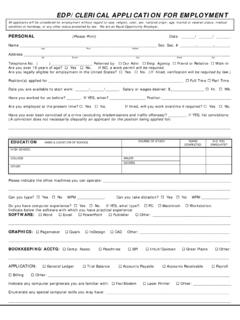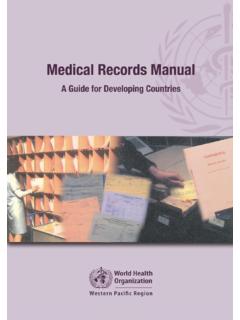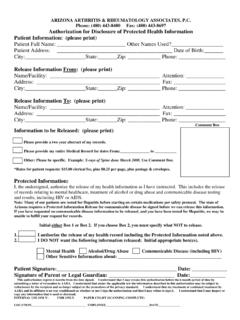Transcription of CHAPTER Introduction to Medical Staff Services
1 Jones & Bartlett Learning, LLC. NOT FOR SALE OR DISTRIBUTION. CHAPTER . Introduction to Medical Staff Services Jodi Schirling, CPMSM. 1. If you have chosen Medical Staff Services as your career path, you have chosen a challenging, exciting, sometimes frustrating, but ultimately very satisfying career. Many of the veteran Medical Staff Services professionals (MSSPs) are passionate about what they do, and they can't imagine working in any other field. Although most days in a Medical Staff Services department are a whirlwind of meetings, telephone calls, conferring with physicians, and many interruptions, the work is consummately interesting, challenging, and fulfilling. Working with a group of highly educated individuals who always strive for perfection and admire competence (physicians) is gratifying.
2 The National Association Medical Staff Services The Medical Staff Services profession has evolved over the past 40 years from a strictly clerical position to one that requires a specific knowledge base. This evolu- tion has been greatly assisted by the professional association, National Association Medical Staff Services (NAMSS). Charlotte Cochrane and Joan Covell Carpenter of California established a Medical Staff Services association in southern California in 1971, which evolved into a national organization in 1976. NAMSS offers educa- tion and many other resources to its members. Affiliated organizations can be found in all states, and many local chapters exist throughout the country. Information about NAMSS and membership can be found at Certification Programs Recognizing that specific knowledge was required to perform the Medical Staff Services and credentialing functions effectively, NAMSS developed a certification program within the first five years of its existence as a national organization.
3 The Certified Medical Staff Coordinator (CMSC) examination was established by a committee led by Cindy Gassiot and was first offered in 1981. It has since evolved into today's Certified Professional Medical Services Management (CPMSM). 1. 1 3/29/2010 10:18:01 AM. Jones & Bartlett Learning, LLC. NOT FOR SALE OR DISTRIBUTION. credential. The CPMSM exam focuses on the management functions in a Medical Staff Services or provider credentialing organization. In 1995, a second certifica- tion program was developed by NAMSS for those who specialize in practitioner credentialing, including the managed care arena, known as the Certified Provider Credentialing Specialist (CPCS) examination. The CPCS exam focuses on the functions of provider credentialing.
4 At the time of this writing, in the United States there are currently 1767 CPMSMs, 2557 CPCSs, and 903 individuals who hold dual certification, for a total of 4324 certified persons. Formal Education Programs Formal education programs in Medical Staff Services have also evolved over the years. The first program was established in Orange County, California, at Cypress College in the mid-1980s, and currently offers an associate degree in Medical Staff Services science. The program consists of 60 semester units and is part of the col- lege's health information technology program. Courses cover Medical Staff Services science, Medical quality management, healthcare law, information technology, Medical terminology, anatomy and physiology, and supervision and management, among others.
5 Beginning in 2000, El Centro College in Dallas, Texas, began offering the first distance education associate degree program. An associate of applied science in Medical Staff Services degree is offered with most of the courses presented online. The 64-credit-hour curriculum includes general education courses as well as courses that address credentialing, privileging, healthcare accreditation, orga- nization of the Medical Staff Services department, Medical Staff law, performance improvement, Medical terminology, anatomy and physiology, pathophysiology, and supervisory management courses, among others. During the final semester, students serve an internship in a Medical Staff Services department. In 2006, the National American University started an online degree program in Medical Staff Services management.
6 The associate of applied science degree focuses on Medical Staff Services administration, accreditation and regulatory compliance, management of credentialing processes, privileging, risk management, Medical Staff law, Medical terminology, peer review, and information management. NAMSS also offers noncredit online courses on various Medical Staff Services and credentialing topics. The Medical Staff Services Professional The evolution of the Medical Staff Services profession can be traced back to the development of the Medical Staff organization. As hospitals began to be held liable for the negligent acts of their Medical Staff members, and as accrediting organiza- 2 CHAPTER 1 Introduction to Medical Staff Services 2 3/29/2010 10:18:01 AM.
7 Jones & Bartlett Learning, LLC. NOT FOR SALE OR DISTRIBUTION. tions strengthened their standards for verifying physician credentials and peer review activities, hospitals began to take a hard look at support for the organized Medical Staff . In the 1970s, the titles of veteran Medical Staff secretaries changed to Medical Staff coordinators. Hospital leaders relied more and more on the coordinator to provide guidance and administrative support for regulatory and accreditation requirements for the Medical Staff organization. Over the years the position expanded and experience gained by the Medical Staff coordinator was amplified by more formal education provided both by NAMSS and college degree programs. Currently, leaders in the Medical Staff Services department (MSSD) hold titles such as manager, director, and even vice president.
8 Today, the MSSP plays a vital role in the various healthcare delivery systems. Whether in a hospital, ambulatory care center, credentials verification organization, or managed care setting, the MSSP brings a range of knowledge and skills essential for each type of organization. This CHAPTER focuses on the role of the MSSP and MSSD in the hospital setting. The MSSP provides coordination for the day-to-day activities of the organized Medical (professional) Staff . Whether in a multifacility organization, an integrated healthcare delivery system, or a small rural hospital, the MSSP acts as the link between the Medical Staff , the administration, and the board. This link is facilitated by the access the MSSP has to both the Medical Staff and the members of the admin- istrative team.
9 In most cases, the MSSP will be one of the first contacts a physician has with the organization. Through the initial credentials verification process and orientation to the organization, the MSSP and MSSD establish a unique relationship with the practitioner. Medical Staff members look to the department for interpretation of bylaws, information on hospital policies and procedures, advice on maneuvering through the sometimes complex administrative structures, and support for the activities of the organized Medical Staff . The MSSP also provides a unique service to the hospital administration. Due to the relationships that develop between the department Staff members and physi- cians, MSSPs are sometimes first to know of an underlying issue within the Medical Staff organization.
10 The issues can be as minor as changes in the physician parking lot or as major as a controversy over new hospital ventures. This information can then be transmitted to the appropriate administrative Staff member for attention or resolution. The MSSP's role is one that engenders trust from both the Medical Staff and the hospital administration. Medical Staff members need to trust that the MSSP and MSSD maintain confidential information, provide accurate and timely information, and respect the confidences of the physicians. The administration needs to trust that the MSSP and the MSSD will maintain accurate records, follow established proce- dures and practices in all activities, maintain activities that meet accreditation stan- dards, alert the administration when accreditation standards are out of compliance, The Medical Staff Services Professional 3.

















